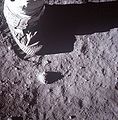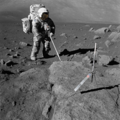Poeira lunar
Poeira lunar (ou solo lunar) é o regolito fino encontrado na superfície da Lua. Suas propriedades podem diferir significativamente das do solo terrestre, e é essencialmente desprovida de umidade e ar, dois componentes importantes encontrados no solo da Terra.
Composição
Origem
Idade da lua
A quantificação mínima de poeira na Lua foi usado uma vez por criacionistas da terra jovem como elementos de prova para uma lua nova. Argumentou-se que com base nas medidas atuais de poeira cósmica e sua taxa estimada de acumulação, a lua deve ser muito jovem. Também foi dito que antes dos desembarques da lua, havia um medo considerável de que os astronautas iriam afundar na poeira. O primeiro uso registrado do argumento foi por Harold Slusher em um artigo publicado pela Creation Research Society em 1971.[1]Henry Morris igualmente publicou a afirmação da poeira da lua em seu livro Scientific Creationism em 1974.[2]
No entanto, a maioria dos criacionistas reconhecem agora o argumento como sendo ultrapassado e aconselham contra o uso dele.[3] Em abril de 1993, Dr. Andrew Snelling e David E. Rush publicaram uma análise extensa e aprofundada do problema no Journal of Creation, 1993.[4] Snelling and Rush, além de revisar dados de análises químicas de sedimentos do mar profundo e poeira no gelo polar e observações de satélite, pesquisa a literatura sobre poeira lunar, fornecendo uma avaliação completa do problema. Eles concluem:
| “ | Calculations show that the amount of meteoritic dust in the surface dust layer, and that which trace element analyses have shown to be in the regolith, is consistent with the current meteoritic dust influx rate operating over the evolutionists’ timescale. While there are some unresolved problems with the evolutionists’ case, the moon dust argument, using uniformitarian assumptions to argue against an old age for the moon and the solar system, should for the present not be used by creationists.[4] | ” |
Interestingly enough, the pioneers for the Apollo landing were actually optimistic about the dust on the moon. Only a few scientists were actually concerned about the levels being to dangerous to tread upon. It is now a known fact that the moon has a very thin layer of dust on its surface, however this actually does not prove that it is a young moon. Satellites have measured the accumulation rates of space dust, and surprisingly the rate of accumulation is quite lower than scientists assumed it to be. This does not prove that the moon is a new moon, nor does it disprove it. No scientist could have known the accumulation rate of dust within previous years compared to the current day. There is only one accurate way to have known if the accumulation rates had changed, someone would have actually had to be present during that time. As far as everyone knows, no one could have known this information more than 100 years ago.[5]
Evolutionary view
Evolutionists have stated that the moon is over 4.5 billion years old due to the assumption that the lunar surface contains several layers of dust. Scientists assume the amount of meteor-like dust falling to the earth is following an "evolutionary process." Due to the size of the moon in proportion to the earth, scientists can estimate the amount of dust falling on the moon by observing the rate of dust fall on the earth. This is a flawed process because the outcome of the assumptions led scientists to believe that there should have been around 500 lbs of dust on the moon's surface! In addition, about 5 billion years ago in the early development stages of the moon and earth, several pieces of rocks, meteors, and stellar dust circled the developing bodies in chaos. These particulates created many craters and formations on both the earth and the moon, thus providing evidence for an accumulation of dust. This is also flawed thinking because there were no sources of gravity big enough to cause such meteor storms in the first place. In order to make sense of all the later information, evolutionists theorize that the moon was still molten during this time and thus burned off several layers of its dust. The problem with this theory is: if the moon had craters inflicted upon it, then dust accumulation, and later most of the dust was burnt off, the craters should no longer exist. Another theory suggests that a cloud of vicious meteors grazed over the surface of the moon 500,000,000 years ago and took a toll on its accumulation of dust. The problem with this theory is that the earth would have also been affected by such a cloud, in which all life would have been destroyed. [6]
Gallery
References
- ↑ Some Astronomical Evidences For A Youthful Solar System by Harold S. Slusher, M.S., Creation Research Society Quarterly Volume 8(1) June, 1971.
- ↑ Morris, Henry. 1974. Scientific Creationism, Green Forest, AR: Master Books, p 152.
- ↑ Arguments we think creationists should NOT use Creation Ministries International, Acessado em 13 de maio de 2010.
- ↑ 4,0 4,1 Moon dust and the age of the solar system by Dr Andrew A. Snelling and David E. Rush. Journal of Creation 7(1):2–42, April 1993.
- ↑ Far Out Claims About Astronomy by Don De Young, Answers in Genesis, 2009
- ↑ Dust on the Moonby Gerardus D. Bouw, Ph.D., The Geocentric Papers, 1993
Ver também
External links
- Recent Impacts on the Moon? by Kevin R. Henke, Ph.D., viewed on 2010, Answers In Creation.
- Reader's Forum by Dick Elmendorf, February 5, 2006.
- Lunar-Surface Closeup Stereoscopic Photography on the Sea of Tranquility (Apollo 11 Landing Site) by Greenwood, W. R.; Jones, R. L.; Heiken, G.; Bender, M.; Hill, R. O, Dec 1, 1971
- NASA TECHNICAL MEMORANDUM (PDF file) By W. R. Greenwood, R. L. Jones, G. H. Heiken, Merritt J. Bender, and Robert O. Hill, 1971
- Impact Metamorphism of Lunar Surface Materials by William Quaide, Theodore Bunch, and Robert Wrigley, 1970.
- Origin of Glass Deposits in Lunar Craters by Jack Green, E. D. Dietz, P. J. Vergano, W. R. Greenwood, Grant Heiken, and T. Gold, © 1970 American Association for the Advancement of Science.
| ||||||||||||||||||||




